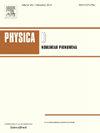Thermocapillary ultrathin self-rewetting film flows down a rotating fibre
IF 2.9
3区 数学
Q1 MATHEMATICS, APPLIED
引用次数: 0
Abstract
This study investigates the influence of thermocapillarity on the dynamics and nonlinear stability of an ultrathin self-rewetting film flowing down a uniformly heated rotating vertical fibre. To capture the combined effects of intermolecular forces (van der Waals attraction) and centrifugal forces (due to rotation), a thin-film evolution equation is derived, assuming the film thickness is much smaller than the fibre radius. Linear stability analysis shows that the van der Waals attraction and rotation always enhance instability, whether acting alone or together. The impact of thermocapillarity in the presence of both van der Waals attraction and rotation on absolute/convective instability is also discussed. When , where is the interfacial temperature and is the temperature at which surface tension is minimum, absolute instability occurs at a lower Marangoni number compared to the case where van der Waals attraction and rotation are absent. When , the convective instability region expands with a higher Marangoni number, even when van der Waals attraction and rotation are present. A weakly nonlinear analysis using the method of multiple scales is conducted to study the bifurcation behavior of the nonlinear evolution equation. The results indicate the existence of both subcritical and supercritical regimes and demonstrate how thermocapillarity, combined with rotation and van der Waals forces, influences the shift of the bifurcation point. Finally, numerical simulations of the nonlinear evolution equation are performed for various flow parameters. These results explain how rotation, thermal effects, and intermolecular forces influence the flow dynamics.
热毛细超薄自湿润膜沿旋转纤维向下流动
本文研究了热毛细对沿均匀加热的旋转垂直纤维向下流动的超薄自重湿膜的动力学和非线性稳定性的影响。为了捕获分子间力(范德华引力)和离心力(由于旋转)的综合效应,推导了薄膜演化方程,假设薄膜厚度远小于纤维半径。线性稳定性分析表明,无论是单独作用还是共同作用,范德华引力和旋转总是增强不稳定性。本文还讨论了在范德华引力和旋转同时存在的情况下热毛细对绝对/对流不稳定性的影响。当Ti<;T0(其中Ti为界面温度,T0为表面张力最小的温度)时,相对于没有范德华吸引和旋转的情况,在较低的马兰戈尼数下会发生绝对不稳定。当Ti>;T0时,即使存在范德华吸引和旋转,对流不稳定区域也会随着Marangoni数的增加而扩大。采用多尺度方法对非线性演化方程的分岔行为进行了弱非线性分析。结果表明存在亚临界和超临界状态,并证明了热毛细作用与旋转和范德华力的结合如何影响分岔点的移动。最后,对不同流动参数下的非线性演化方程进行了数值模拟。这些结果解释了旋转、热效应和分子间作用力如何影响流动动力学。
本文章由计算机程序翻译,如有差异,请以英文原文为准。
求助全文
约1分钟内获得全文
求助全文
来源期刊

Physica D: Nonlinear Phenomena
物理-物理:数学物理
CiteScore
7.30
自引率
7.50%
发文量
213
审稿时长
65 days
期刊介绍:
Physica D (Nonlinear Phenomena) publishes research and review articles reporting on experimental and theoretical works, techniques and ideas that advance the understanding of nonlinear phenomena. Topics encompass wave motion in physical, chemical and biological systems; physical or biological phenomena governed by nonlinear field equations, including hydrodynamics and turbulence; pattern formation and cooperative phenomena; instability, bifurcations, chaos, and space-time disorder; integrable/Hamiltonian systems; asymptotic analysis and, more generally, mathematical methods for nonlinear systems.
 求助内容:
求助内容: 应助结果提醒方式:
应助结果提醒方式:


